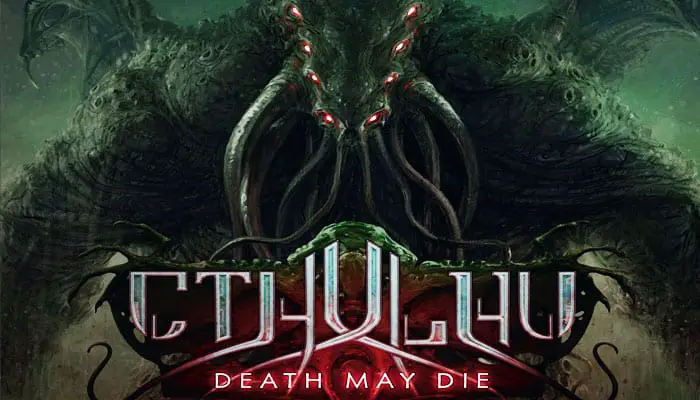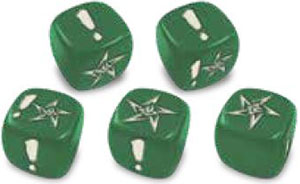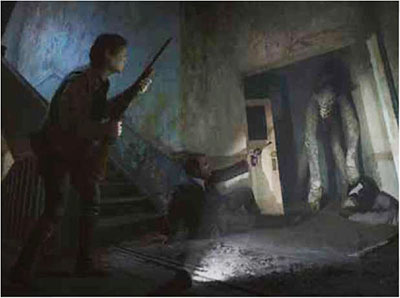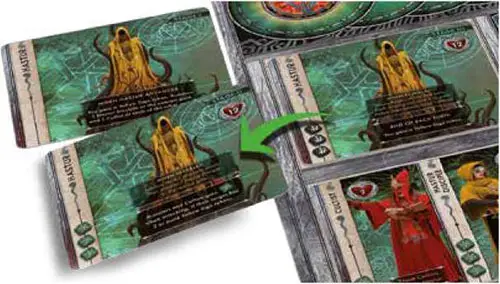
Components

- 17 Double-Sided Tiles
- 12 Insanity Cards
- 5 Bonus Dice
- Story Board
- 5 Colored Bases
- 30 Tentacle Markers
- 3 Standard Dice
- 1 Starting Space Token
- 26 Wounds Tokens
- 3 Gate Tokens
- 1 Progression Token
- 2 Staircase Tokens
- 2 Tunnel Tokens
- 6 Level 1 Skill Tokens
- 8 Fire Tokens
- 2 Elder One Boxes
- 6 Episode boxes
- 10 Investigators + Boards
- 10 Cultists
- 18 Monsters
- Rulebook
Overview
Click here for the overview of all the game elements.
Setup

-
Set out the Story Board, tokens, and dice.
-
Choose an Elder One. From its box, place the Elder One figure on the starting space of the summoning track. Place the Minions reference card on the Story Board. Set out the 8 Mythos cards and any tokens.
Place the Elder One Stage cards in order, faceup, on the Story Board. Stage 1 goes on top.
-
Choose an episode. From its box, take out its 8 Mythos cards, 15 Discovery cards, Episode card, and tokens. Place the Monsters reference cards on the Story board.
-
Take out all the figures for the enemies shown on the reference cards (other monsters won't be used).
-
Set up the map board according to the instructions on the back of the episode card, including arranging the map tiles and setting enemy figures and tokens on the indicated spaces. Then, turn over the episode card and place it on the Story board.
-
Shuffle the 16 Mythos cards together and place them facedown.
-
Shuffle the episode Discovery deck and place it facedown.
-
Have each player select an investigator board and its figure. Attach a colored base on the figure to help you remember which figure is yours. Place the figures on the starting space for the episode.
In a single-player game, choose 2 investigators. You will control both, alternating turns with them.
-
Place the 6 markers of your color on your investigator board: 3 on the first level of your investigator's skills, and the other 3 in the leftmost space of the wound, stress and sanity tracks.
-
Shuffle the insanity cards and deal 1 to each player, putting away the rest. Players place their card, faceup, near their investigator boards.
-
Randomly determine a starting player. That player takes the Mythos deck and will take the first turn.
Dice and Checks

Some actions and Discovery cards tell you to "make a roll". When investigators make a roll, you always roll 3 standard black dice (and may also be allowed to add bonus green dice).
Enemies roll a specific number and type of dice for their attacks, as indicated on their reference card.
Each die has 4 different possible results:
-

Success: This means that you (or the enemy) succeeded at your attempt (or partially succeeded). If you were attacking, it means you hit. If an enemy is attacking, it means they hit you.
In some cases, you need to reach a target amount of successes in a single roll. Perhaps you need at least 2 successes to loot a body.
-

Elder Sign: These mean nothing unless you have a skill or card that uses them.
-

Tentacle: Madness! For each tentacle, you lose 1 sanity, moving your tracker 1 space to the right.
Important: Tentacles on EVERY roll cost you sanity, whether you're attacking, being attacked, or just "making a roll".
-

Blank: No effect most of the time.
Bonus Dice

Certain skills and cards may give you bonus green dice, as noted on their description. Some checks may also give you bonus dice if you have a related ability. Finally, reaching certain Insanity Thresholds will add permanent bonus dice to all your rolls.
There is no limit to the number of bonus dice that may be added to a roll (if you run out of dice, note the results and roll the same dice again).
Note: The bonus dice do not contain a tentacle icon.
Rerolls

After rolling dice, you may take 1 stress to reroll 1 die, ignoring its original result.
You may do this as often as you like on any roll you make, until your stress is at the maximum.
When enemies attack you, you roll for them and may also take stress to reroll their dice.
Applying Results
Once you're done using any rerolls, tally the number of each result obtained (note that some die faces contain 2 results). Make sure to apply any symbol changes from abilities (such as counting  as successes). Then apply the results of the dice roll in this order:
as successes). Then apply the results of the dice roll in this order:
-
Use any Successes:
If an investigator is attacking, these successes are wounds applied to their target.
If an enemy is attacking, successes are also wounds applied to their target (usually an investigator).
If you were told to "make a roll" by an action, you must match or exceed the number of successes indicated on the card to be successful.

The episode allows the investigator to make a special action.
While you are on a space with a Cultist body, make a roll. If the roll has 2 or more successes, you manage to loot the Cultist body.
-
Resolve Effects:
Resolve any effects that may be tied to the result of the roll. (Examples: "If wounded.. "",,If it survives an attack.."., "When the enemy dies..").
-
Apply any Tentacles:
Lose 1 sanity for each tentacle rolled (move your marker 1 space to the right on your sanity track).
If you reach a
 space on your sanity track, stop moving the marker (even if you didn't lose the full amount of sanity), activate your insanity, and level up a skill.
space on your sanity track, stop moving the marker (even if you didn't lose the full amount of sanity), activate your insanity, and level up a skill.
Game Play
Turn Sequence:
- Take 3 Actions
- Draw Mythos Card
- Investigate Or Fight!
- Resolve End Of Turn
1. Take 3 Actions
On your turn, you may take 3 actions. You may take the same action more than once. There are 4 actions that are available in every episode and 2 that are unique to each episode.
Some actions can only be done while on a Safe space. A Safe space is a space without enemies.
Run
Move up to 3 spaces. You can only move between spaces if there is a passage on both tiles (as indicated by arrows on both sides). You may also pass between 2 spaces that both have a staircase or tunnel token.
When you leave a space with enemies, ALL enemies in that space follow you to your new space (even if there were other investigators in your space).
When you leave a space with Fire tokens, place 1 Fire token from the reserve onto your investigator board for each token on the space, leaving those tokens untouched.
Example: Ian uses a Run action to move up to 3 spaces. He first moves into a space with a Cultist.

He keeps moving and the Cultistfollows him to the new space. The second space has 2 Fire tokens, but no enemies.

Ian finishes his Run by moving into a third space, which contains a Fire Vampire. Again, the Cultistfollows him. He is also leaving a space with 2 Fire tokens, so he takes 2 Fire tokens from the reserve and adds them to his investigator board.
He is now in a space with a Fire Vampire and the Cultist who followed him. He is also on Fire. Pretty typical evening.

Attack
Target a single enemy in your space and make a roll. Each success rolled causes 1 wound to your target. Place wound tokens next to the base of the figure you attacked.
If this number equals (or exceeds) their health, you kill them. Remove their figure from the board. Keep in mind that even if the Elder One is on the board, it can only be attacked once the ritual is disrupted.
Example: Ian uses an action to attack a Cultist and a Fire Vampire. Normally, he would have to target either the Cultist or the Fire Vampire, but his level 2 Brawling skill enables him to target all enemies in his space, so he doesn't have to choose.

He takes 3 standard dice (you always take 3 standard dice when "making a roll") and 1 bonus die for his Brawling skill.

He rolls and gets a blank, a success, a success + tentacle, and an elder sign. Ian doesn't have a skill that utilizes the elder sign, so it has no effect. Ian takes a stress to reroll the blank and gets another success!
He takes another stress to reroll the elder sign and gets another elder sign. He decides to stop rerolling.


The Cultist can take 2 wounds and the Fire Vampire can take 4.
Ian has 3 successes to distribute as hits. He decides to use 2 to kill the Cultist, removing the figure and, using his Brawling skill, applies the last success as a hit to the Fire Vampire.
Note: If the investigator didn't have the Brawling skill, he would have to deal all wounds to a single enemy (chosen before rolling dice), even if excess wounds would go ignored with no effect.
Finally, Ian loses 1 sanity from the tentacle rolled. One step closer to madness.

Rest (Only on a Safe Space)
If you are in a Safe space (there are no enemies with you) you may heal your stress and/or health up to 3 spaces (in any combination). This is 3 spaces total, not 3 spaces for each track. You may perform the Rest action more than once per turn.
Important: Sanity Cannot Be Healed By Resting!
Example: Sister Beth is at full stress and has taken 1 wound. She spends an action to Rest. She could choose to heal 1 wound and 2 stress, but decides to heal 3 stress instead, leaving her health where it is.
Trade
You and all investigators in your space may trade any number of Items or Companions with each other (either giving or receiving). While some Discovery cards have Items or Companions on both the left and right side of the card, a traded card must remain on the same side as it was originally.
You may not trade Conditions.
Episode Actions
Each episode has 2 unique actions as shown on the episode card. These work just like the standard actions, and will help you disrupt the ritual or help you survive.

2. Draw Mythos Card
Draw the top Mythos card from the deck and resolve it. Then place it on a faceup discard pile.
Note: The Recurring Trauma insanity has an investigator keep a previously drawn Mythos card in front of them.
Mythos cards may have several different steps to them, divided into
3 types. You must do these steps in order, from top to bottom, before discarding the card. If you can't do a step on the card, skip it and move on to the next.
Elder One Summoning

This has no effect when the card is drawn, but may cause the Elder One to advance at the end of the turn).
If the card has this symbol, make sure it remains visible when it is discarded.
Special Effects
Mythos cards have all sorts of different special effects to make life hell. Unless otherwise stated, these effects only affect the player whose turn it is, ignoring all other investigators.
Any choice that needs to be made is up to the active player, such as chosing which "closest" figure to move.
When an effect moves an enemy towards a space, it should be moved by the shortest path to that space. Count how many spaces the enemy would move in all possible paths, and choose the shortest one.
In case of a tie, the active player chooses. The enemy must always be moved as much as allowed towards its target, but stops when it reaches its target.
Summon Enemies
Finally, the bottom of some cards will indicate a Gate color and the specific enemy that must be summoned there. If you have the corresponding figure available in reserve, place it on the indicated space.
Otherwise, ignore this step. If there are multiple Gates and enemies indicated, perform the summonings in order. Skip any remaining Gates if you are out of figures.
3. Investigate or Fight
This step varies depending on whether there are enemies in your space or not.
If you are in a safe space, investigate your space:
Draw the top card of the Discovery deck and read the text in the center box aloud.
Some cards will have a statement of something you must do if you have a Condition or a certain Companion. Most offer choices of what you want to do.
Some cards result in CLAIMING a Companion, Item, or Condition. Claiming means to slide the card under your investigator board, becoming part of your inventory (or, when it's a Condition, changing your mental state).

When you first draw a Discovery card, read the central text out loud. This card has a bit of speech from the Assistant Janitor. It then tellsyou to take 1 stress if you have the Guilty Conscience Condition.
Then, you have a choice of either taking 2 stress to Claim the Janitor or 1 stress to Claim the Bleach.
Companions:
Any wounds you take may be applied to Companions you currently have instead. This still counts as you taking wounds for card effects. Companions can never be healed. If their wounds equal the number on their card, the Companion is discarded and any benefit they give you is immediately lost.
Companions may also give you a level in a skill. If you don't have that skill, you gain level 1 in that skill while you have this Companion with you (take the corresponding token).
If you already have the skill, move the skill level marker 1 level forward. If you lose the Companion, move the marker back 1 level.

Jerome, the Assistant Janitor, gives you 1 level in Stealth while you have him.
He also can take 1 wound (which would kill him).
If you are not in a safe space, the enemies fight you:
Do not draw a Discovery card. Instead, each enemy in your space attacks you in the order you choose (they ignore other investigators), until all enemies in your space that could attack you have done so.
Important: If an effect makes you enter a space of an enemy, or an enemy enters your space during this phase, that enemy attacks you even if it was not in your space at the beginning of this phase. Also, if an enemy that was in your space leaves your space, it doesn't attack you anymore.
Defending Against Enemies
When an enemy attacks you, roll the number and type of dice as shown on their reference card. Each success gives you 1 wound. Each tentacle costs you 1 sanity.
Elder signs only have an effect if the enemy has the ability to use them. You may use stress to reroll these dice and you may use any of your skills to help avoid or minimize the attack.
4. Resolve End of Turn
-
End of Turn Effects
Any effects that happen at the end of the turn, except for Elder One effects, happen now, in any order the active player chooses.
-
Fire!
You may be on fire. This will have happened if you left a space that contains Fire tokens. It may be that a monster set you on Fire. At this point, it really doesn't matter, does it?

At the end of your turn, roll 1 standard die for every Fire token on your investigator board.
You may use stress to reroll dice. Take 1 wound for each success and lose 1 sanity for each tentacle. Then, discard all Fire tokens on your investigator board.
Note: Enemies don't catch Fire when leaving a space with Fire tokens.
Running Out Of Fire: If you need to add a Fire token to the board but there are none left, ignore the effect. If you need to add a Fire token to your investigator board but there are none left, use a wound token instead.
-
Check the Mythos Discard Pile

If there are 3 cards in the discard pile that have the Elder One Summoning symbol, the Elder One advances toward ultimate power!
If there are 3 Elder One Summoning symbols:
Advance the Elder One along the Summoning track. If the Elder One is already on the board, move the Progression token along the track instead. The revealed Elder One Stage cards and the Episode card will tell you what to do when the Elder One advances. Resolve the Elder One effects first.
It doesn't matter whether it's the Elder One figure or the Progression token advancing on the Summoning track, the effects are resolved in the same way.

After the Elder One advances, all of the discarded Mythos cards are shuffled back into the deck.
-
Check the Elder One Summoning
The Elder One is summoned if:
The Elder One entered the first red space on the track; OR
The ritual was disrupted this turn.
When the Elder One is summoned to our world, move the Stage 1 card to the side, revealing the Stage 2 card underneath. Resolve its reveal effects, which will specify where the Elder One must be summoned. The Stage 1 effects remain in play until the end of the game.

Place the Progression token on the Summoning track on the space previously occupied by the Elder One figure.
Use this Progression token to mark the Elder One's progress until the end of the game.
-
Elder One End of Turn Effects
As the Elder One progresses through its stages, there may be "End of Turn" effects visible on its Stage cards.
Resolve all effects on each Stage card in the order of the Stages: First 1, then 2, then 3, and then Final. Any effect that refers to "you" is referring solely to the investigator whose turn it is.
The turn is now over, and the player to the left takes their turn. Continue taking turns like this until the investigators either win or lose.
Death of an Investigator
When an investigator is killed or consumed by madness, the game is immediately lost if the Elder One is still on the Summoning track. If, however, the Elder One has already been summoned to the board, the other investigators may continue playing and try to win the game.
First, discard all Discovery cards and tokens that investigator had. The episode may specify something to do with any special tokens the investigator had been holding.
If the investigator died during their turn, skip all the following turn phases except for the Check the Mythos Discard Pile phase.
If there are 3 Elder One Summoning symbols, the Elder One advances and its effects are applied (if it is needed to determine the position of the dead investigator, use the space where they died). From now on, that player's turn is skipped entirely.

Disrupting the Ritual
Each episode describes the tasks the investigators must accomplish in order to disrupt the Cultists' ritual and make the Elder One mortal, even if only for a short time.
The Elder One cannot be attacked or damaged until the ritual is disrupted (though it can attack you if it's on the board)! If the investigators disrupt the ritual, the Elder One is summoned at the end of the turn.
Fighting the Elder One
Once the Elder One is summoned to the board, it acts like any enemy, attacking investigators that end their turn in its space. The number and type of dice the Elder One rolls is the total of all dice displayed on all its revealed Stage cards.
Until the ritual is disrupted, the Elder One cannot be attacked or damaged, even if it's already been summoned to the board by reaching the red space on the summoning track!
After the ritual is disrupted, the Elder One can be attacked and damaged like any other enemy. The Elder One has multiple Stages, with individual healths, which must be defeated one at a time until it's ultimately destroyed.
Starting with Stage 2, each card displays:
- A one-time effect that takes place when that card is revealed.
- An ongoing effect that remains in play until the end of the game.
- Health showing how many wounds that Stage can take.
- The number and type of dice that Stage adds to the Elder One's attacks.
When a Stage has wounds equal to or greater than its health, that Stage is defeated. Move that Stage card to the side to reveal the next and resolve its "When Revealed" effect.
Any excess wounds do NOT carry over to the next Stage. Remember that all of the previous Stages' effects and dice remain in play until the end of the game!

Example: An investigator attacks Hastur while he is in Stage 2. That Stage already has 9 wounds from earlier attacks. The attacking investigator does 5 wounds!
This new total of 14 is enough to defeat this Stage's 12 health. The Stage card is moved to the side, next to Stage 1, and revealing Stage 3. Even though the investigator only needed 12 wounds to defeat the Stage and did 14, the extra 2 wounds do NOT carry over to Stage 3.
Hastur is moved to the Red Gate, and any investigator with at least 2 Yellow Signs takes 1 wound. Hastur now rolls 3 bonus dice AND 3 standard dice when attacking!
End of the Game
You all win the game when you kill the Elder One by defeating its Final Stage.
If multiple end-game triggers happen at the same time, winning conditions have precedence.
Example: The Elder One and the last investigator die at the same time. The players saved the world and win the game.
You all lose the game when one of the following happens:
An investigator is killed or consumed by madness before the Elder One is summoned to the board (Stage 1 card).
All investigators are killed or consumed by madness after the Elder One is summoned (Stages 2 onward).
The Progression token reaches the last (8th) space of the Summoning track.
Continue Reading


